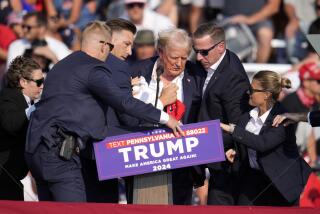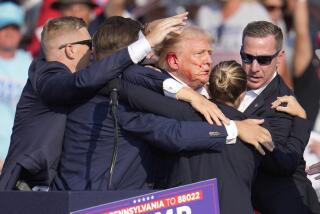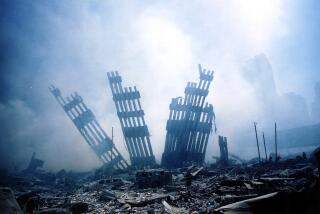9/11 Report Cites CIA, FBI Lapses
WASHINGTON — U.S. intelligence squandered its “best chance” to uncover the Sept. 11 plot by missing repeated opportunities to track two San Diego-based hijackers, according to a long-awaited congressional report released Thursday that documents years of intelligence breakdowns and feckless attempts to penetrate or strike Al Qaeda.
The nearly 900-page report provides a sweeping and damning account -- with plentiful new details -- of the U.S. government’s counter-terrorism efforts in the years leading up to the Sept. 11 attacks.
It documents covert CIA missions that never got close to their target, portrays the Pentagon as deeply reluctant to launch missions against Osama bin Laden until it was too late, raises new suspicions about possible links between Saudi Arabia’s government and some hijackers, and cites chronic breakdowns in the sharing of critical information.
The report discloses top-secret communications intercepts in which at least two of the hijackers were identified and linked to a terrorist facility in the Middle East two years before the attacks -- information collected by the National Security Agency but not shared in time with the FBI or other agencies.
It sheds new light on the hijackers’ activities in the United States, undercutting FBI claims that they did nothing to arouse suspicion once they had entered the country.
And the report produces new evidence that the intelligence community had clues years before the attacks that Al Qaeda was interested in hijacking planes in the United States.
One new disclosure points to a December 1998 intelligence report, from an unidentified source, in which an Al Qaeda operative described plans to hijack U.S. aircraft as “proceeding well” and referred to a “dry run” in which two individuals had successfully evaded checkpoints at a New York airport.
A U.S. intelligence official confirmed there was such a report and said it was shared broadly throughout the U.S. government. But he said that it was unsubstantiated and that the CIA and FBI have never confirmed whether there ever was such a “dry run” at the airport.
The congressional report finds that no agency had specific information that would have enabled it to anticipate the Sept. 11 attacks, which killed about 3,000 people. Nevertheless, the report strongly suggests that the attacks might have been prevented.
Indeed, a congressional official who briefed reporters on the document Thursday said it would be wrong for intelligence agencies to conclude “that you didn’t have a formal announcement of the details of the Sept. 11 attacks, and therefore you couldn’t have prevented it.”
Rather, the official said, “the message should be ... that we cannot afford to wait for formal announcements. We have to have an intelligence community that is able to connect the dots.... And that, unfortunately, was not what we saw in this case.”
Relatives of victims of the attacks said they were troubled by the litany of failures cited in the report. “I am just utterly saddened,” said Kristen Breitweiser, whose husband was killed at the World Trade Center. “There are so many links in the chain of failure that day -- if those links had held, my husband’s life was one of those that could have been saved.”
In a statement, President Bush thanked the joint committee for its “hard work and careful thought” but did not address any particulars of the report. Instead, he cited steps the administration has taken to improve domestic security, such as creation of the Department of Homeland Security, and cooperation among intelligence agencies.
“Our law enforcement and intelligence agencies are working together more closely than ever and are using new tools to intercept, disrupt and prevent terrorist attacks,” Bush said. “The best way to prevent future attacks is to hunt down the terrorists before they strike again.”
The report represents the culmination of a joint inquiry that involved nearly two dozen hearings, thousands of interviews with current and former government officials, as well as the review of about 500,000 documents.
The release of the report had been delayed for months amid intense wrangling between Congress and the White House over how much information could be declassified and shared with the public. Large chunks of material were censored, leaving blacked-out spaces on dozens of pages.
White House spokesman Scott McClellan defended the deletions, saying they affected “only the most sensitive of national security information.”
But others accused the White House of withholding information that might have embarrassed the administration or strained relations with foreign governments. Some of the deleted text is said to have explored alleged financial and other links between the terrorists and Saudi Arabia, home to 15 of the 19 hijackers.
“I remain deeply disturbed by the amount of material that has been censored from this report,” said Sen. Bob Graham (D-Fla.), co-chairman of the joint inquiry, which included members of the Senate and House intelligence committees.
Although the report traces counter-terrorism efforts dating to the 1980s and the rise of Al Qaeda through the 1990s, many of its key findings center on the activities of two hijackers who were based in San Diego and whose connection to Al Qaeda was known by the CIA -- but not by the FBI until too late.
Putting those two hijackers under surveillance “would have given the San Diego FBI field office perhaps the intelligence community’s best chance to unravel the Sept. 11 plot,” the report concludes. “That chance unfortunately never materialized.”
The report cites a series of breakdowns that contributed to that failure.
Nawaf Alhazmi and Khalid Almihdhar had more visible links to Al Qaeda than any of the other hijackers. The CIA had observed both men attending an Al Qaeda meeting in Malaysia in January 2000. Two months later, the CIA learned that Alhazmi had entered the United States. Indeed, both men had arrived in Los Angeles on Jan. 15.
But the agency failed to put either man on U.S. government watch lists until Aug. 23, 2001, just weeks before the attacks. This information has been previously disclosed, but the report provides a detailed new understanding of the hijackers’ activities and the clues that were missed.
But the report also makes clear that the FBI squandered repeated opportunities of its own. The men had repeated contacts with a longtime FBI informant in San Diego, according to the report. The report does not specify the nature of the contacts, but a federal law enforcement source said Thursday that the informant was Abdussattar Shaikh, the two men’s landlord.
The report was sharply critical of the FBI on a number of fronts, challenging FBI Director Robert S. Mueller III’s testimony last year that the hijackers had “contacted no known terrorist sympathizers in the United States” or otherwise aroused any suspicions.
At least five of the hijackers operated “within the scope of the FBI’s coverage of radical Islamic extremists,” the report says.
Hijackers Hani Hanjour, Mohamed Atta, Marwan Al-Shehhi, Alhazmi and Almihdhar all appear to have had contact with individuals who “had come to the FBI’s attention” during counter-terrorism or counter-intelligence investigations. Four of those people were the focus of active FBI investigations during the time the hijackers were in the U.S.
Mueller later acknowledged to the committee that its investigators had brought new information to his attention. The report notes that the director said in a subsequent hearing: “I can assure the committee that I had no intent to mislead.”
The FBI had little luck cultivating sources in Islamic fundamentalist communities in the United States, the report notes, partly because only 21 FBI agents spoke Arabic.
The report is also replete with damning quotes about the FBI’s counter-terrorism performance in general.
Richard Clarke, a former counter-terrorism advisor to Presidents Clinton and Bush, told investigators he was dismayed when he visited FBI field stations around the country to ask what they were doing about sleeper cells.
“I got sort of blank looks.... What is Al Qaeda?” Clarke said.
A senior FBI official called the report a fair and accurate assessment of the bureau’s pre-Sept. 11 shortcomings.
“This report gave us a good overview of where a number of failures took place, not just at the FBI but throughout the government,” the senior official said. “But nothing in this report says we really could have stopped it. If we had gotten the information sooner from the CIA, would we have been able to do more? I’m not sure. It is a much bigger picture than even the report indicates. There are any number of ways to second-guess this.... The one thing that’s needed is for FBI and CIA to get together and work together, and that’s what we are doing.”
The CIA also comes under harsh criticism in the report, which documents its unsuccessful attempts to penetrate Al Qaeda in the late 1990s.
The CIA was never able to get any of its spies close to Bin Laden, the report concludes, and largely generated only “secondhand, fragmented and often questionable human intelligence information” on the terrorist.
In the summer of 1999, the CIA began assembling what it called “The Plan,” a covert strategy to penetrate Al Qaeda and target Bin Laden. But again resources and focus were lacking, the report concludes, and ultimately, “the CIA was not able to mount a single operation against Bin Laden before Sept. 11.”
U.S. counter-terrorism officials told investigators that they had “numerous unilateral sources outside” Al Qaeda’s leadership ranks. The report also says the CIA managed a network of informants in Afghanistan that often reported on Bin Laden and the Taliban.
But the agency “had no penetrations of Al Qaeda’s leadership,” according to the report. Even when they thought they had a momentary bead on Bin Laden, they advised against acting on the information “because they said their sources were not very good, or not good enough to recommend military action,” Clarke is quoted in the report.
The one strike on Bin Laden, cruise missile attacks in Sudan in August 1998 in retaliation for the bombings of U.S. embassies in Africa, was unsuccessful.
The Clinton administration never got another opportunity, even though from 1999 to 2001 Clinton had ordered two submarines and Navy ships loaded with cruise missiles on “perpetual deployment” in the North Arabian Sea off the coast of Pakistan.
The report indicates senior military leaders were reluctant to put U.S. forces much closer than that coastline.
In late 2000, Gen. Henry H. Shelton, then chairman of the Joint Chiefs of Staff, prepared a paper with 12 or 13 options for using force against Bin Laden. Several involved “U.S. boots on the ground” in Afghanistan aimed at capturing Bin Laden.
But Clarke told the joint inquiry that when military operations on Al Qaeda were discussed, “the overwhelming message to the White House from the uniformed military leadership was, ‘We don’t want to do this.’ ”
Military officials cited the dangers of dropping forces into a hostile country far from any logistical support, but also seemed to have low confidence in U.S. intelligence in Afghanistan.
Said a former chairman of the Joint Chiefs who was not identified by name: “You can develop military operations until hell freezes over, but they are worthless without intelligence.”
The CIA in turn described the military’s intelligence requirements as “absolutely impossible,” in the words of one counter-terrorism official. The military, the official said, wouldn’t launch an operation until it knew “which side of the door are the hinges on, do the windows open out or go up and down.”
Special operations officers said they were eager to mount an operation against Bin Laden and had the ability to put small teams into Afghanistan.
A CIA document assessing the prospects cited “lots of desire” on the part of lower-level military officials but “reluctance at the political level.”
Even so, aspects of the CIA’s plan were instrumental in the success of the war in Afghanistan in October 2001. Clarke said the war represented the agency’s strategy “telescoped and done very quickly in six months instead of three years.”
U.S. government efforts to track terrorist funding before Sept. 11 were sporadic and often poorly coordinated, the report found. They were no match for Al Qaeda’s sophisticated use of cash smuggling, international banking and the informal networks of money transfers known as hawalas.
*
Times staff writers Richard Serrano, Josh Meyer, Adrianne Goodman, Nick Anderson and Susannah Rosenblatt contributed to this report.
For the full text of the joint House-Senate inquiry into the Sept. 11 terrorist attacks, go to latimes.com/911inquiry.
More to Read
Sign up for Essential California
The most important California stories and recommendations in your inbox every morning.
You may occasionally receive promotional content from the Los Angeles Times.










